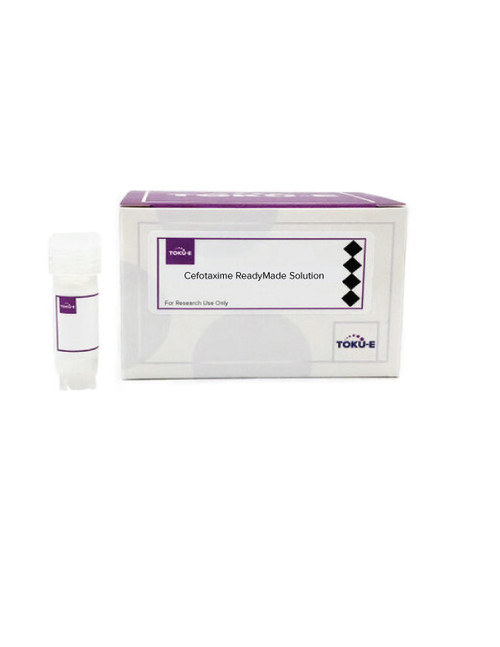Nisin ReadyMade™ Solution is provided as a sterile-filtered solution in 0.02N HCl at a concentration of 20,000-40,000 IU/ml. Nisin is a low molecular weight, natural antibacterial pentacyclic peptide used as a food grade preservative. Nisin is produced by lactic acid bacterium Lactoccus lactis, widely used in cheese manufacturing. Nisin belongs to a cationic peptide group called Type A lantibiotics, named after the unusual amino acid lanthionine. There are 34 residues in the peptide. Nisin was isolated in the 1930s and is used for therapeutic and industrial applications due to its high safety profile. It has antibiotic action against a range of food spoilage bacteria and is heat-stable. It has applications in biomedicine including cancer and veterinary research. There are 8 natural variants of Nisin: Nisin A, Z, F, Q, H, U, U2 and P.
The activity of Nisin is measured in International Units (IU), which refers to the amount of Nisin required to inhibit growth of 1 bacterial cell in 1 ml of broth. One IU of Nisin is equivalent to 0.025 micrograms.
We also offer:
| Mechanism of Action | Nisin binds to lipid II which is a membrane-bound advanced intermediate involved in cell wall biosynthesis. It sequesters lipid II from its functional location. The nisin-lipid II complex leads to formation of pores in the bacterial membrane leading to bacterial cell death. |
| Spectrum | Nisin is effective against Gram-positive bacteria, but has little or no effect on Gram-negative bacteria, yeasts, or fungi. |
| Microbiology Applications | Nisin can interact with the SARS-CoV-2 (2019 nCoV) spike protein receptor human antiotensin-converting enzyme 2 (hACE2) as found by in-silico homology modeling and docking of all 8 Nisin variants. Among the Nisin variants, Nisin Z and Nisin H showed significant binding affinity.
The spike protein on the outer surface of SARS-CoV-2 virus is a recognition factor for its attachment and entry to the host cells. In humans, the receptor binding domain (RBD) of the spike protein binds to hACE2. Small peptides are suitable for disrupting protein-protein interactions (PPI) and have reduced immunogenicity, thus they are ideal candidates for novel therapeutics. The currently used peptides for COVID-19 are all synthetic and costly. |
| Eukaryotic Cell Culture Applications | The influence of Nisin was evaluated on the proliferation and apoptosis of an astrocytoma cell line (SW1088). Cell death and apoptosis were significantly increased following Nisin treatment. This is a promising feature of Nisin for anti-cancer therapy.
Diabetic foot ulcers (DFUs) are major complications of Diabetes mellitus. They are often recalcitrant to conventional antibiotics and alternatives are needed. The 3D collagen model used Nisin in combination with Pexiganan to control co-cultures of S. aureus and P. aeruginosa using a guar-gum delivery sysem (dual-AMP biogel) to eradicate S. aureus from the model (Gomes et al, 2020). |
| Molecular Formula | C143H230N42O37S7 |
| References |
Bhattacharya R, Mitra S, Manda S, Biswas SR (2020) A natural food preservative peptide Nisin can interact with the 2019-nCoV spike protein receptor ACE2. Preprint. Vers. 1. doi 10.21203/rs.3.rs-48319/v1] Garcia-gutierrez, E. et al. First evidence of production of the lantibiotic Nisin P. 1– 15 (2020) doi:10.1038/s41598-020-60623-0 Gomes D et al (2020) Pexiganan in combination with Nisin to control polymicrobial diabetic foot infections. Antibiotics 9(128) PMID 32244862 Hansen JN (1994) Nisin as a model food preservative. Crit Rev Food Sci Nutr. 34(1):69-93 PMID 8142045 Leitao JH (2020) New insights into antibacterial compounds: From synthesis and discovery to molecular mechanisms of action. Antibiotics 9(8):471 Rollema HS, Kuipers OP, Both P, de Voss WM, Siezen RJ (1995) Improvement of solubility and stability of the antimicrobial peptide Nisin by protein engineering. App. Environ. Microbiol. 61 (8):2873-2878 Sharma VK, Jinadatha C and Lichfouse E (2020) Environmental chemistry is most relevant to study coronavirus pandemics. Environ. Chem. Lett. 18:993-996 Zainodini N et al (2018) Nisin induces cytotoxicity and apoptosis in human asterocytoma cell line (SW1088). Asian Pacific J. Cancer Preven. 19(8):2217-2222 |








